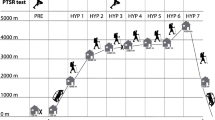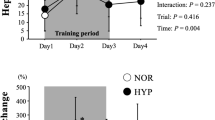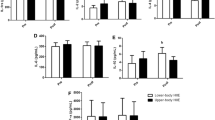Abstract
The purpose of the present study was to compare the acute hormonal response to a short-term high-intensity training (HIT) versus a high-volume endurance training (HVT) and to investigate the effects of acid–base status on cytokines involved in angiogenesis (VEGF and bFGF). Eleven subjects participated in three experimental trials. Two times subjects performed four 30-s “all-out” exercise bouts on a cycle ergometer separated by 5-min rest each, at which subjects either received bicarbonate (HIT (B)) or a placebo (HIT (P)) before the exercise. The third exercise trail consisted of a constant load exercise for 1 h at 50% peak power output (PPO). Venous blood samples were taken under resting conditions, 10, 60, and 240 min after each exercise condition to determine VEGF and bFGF serum concentrations. Capillary blood samples were taken to determine lactate concentrations and blood gas parameters. Mean pH values were significantly higher during HIT (B) compared to HIT (P). Serum VEGF concentration was significantly increased 10-min post-exercise in both HIT interventions. HVT showed no significant effects on VEGF levels. The diminished acidosis during HIT (B) had no effects on the VEGF response. There were no significant changes in bFGF in response to HIT or HVT. The present study suggests that HIT is a stimulus for exercise-induced VEGF secretion. These findings might be relevant for the arrangement of training, due to the fact that most of the training is often performed at low intensities possibly leading to an insufficient stimulus for VEGF secretion and angiogenesis.





Similar content being viewed by others
References
Adams V, Lenk K, Linke A, Lenz D, Erbs S, Sandri M, Tarnok A, Gielen S, Emmrich F, Schuler G, Hambrecht R (2004) Increase of circulating endothelial progenitor cells in patients with coronary artery disease after exercise-induced ischemia. Arterioscler Thromb Vasc Biol 24:684–690
Adams V, Linke A, Breuckmann F, Leineweber K, Erbs S, Krankel N, Brocker-Preuss M, Woitek F, Erbel R, Heusch G, Hambrecht R, Schuler G, Mohlenkamp S (2008) Circulating progenitor cells decrease immediately after marathon race in advanced-age marathon runners. Eur J Cardiovasc Prev Rehabil 15:602–607
Bassett DR Jr, Howley ET (2000) Limiting factors for maximum oxygen uptake and determinants of endurance performance. Med Sci Sports Exerc 32:70–84
Brown MD, Hudlicka O (2003) Modulation of physiological angiogenesis in skeletal muscle by mechanical forces: involvement of VEGF and metalloproteinases. Angiogenesis 6:1–14
Brown MD, Walter H, Hansen-Smith FM, Hudlicka O, Egginton S (1998) Lack of involvement of basic fibroblast growth factor (FGF-2) in capillary growth in skeletal muscles exposed to long-term contractile activity. Angiogenesis 2:81–91
Burbridge MF, West DC, Atassi G, Tucker GC (1999) The effect of extracellular pH on angiogenesis in vitro. Angiogenesis 3:281–288
D’Arcangelo D, Facchiano F, Barlucchi LM, Melillo G, Illi B, Testolin L, Gaetano C, Capogrossi MC (2000) Acidosis inhibits endothelial cell apoptosis and function and induces basic fibroblast growth factor and vascular endothelial growth factor expression. Circ Res 86:312–318
Egginton S (2009) Invited review: activity-induced angiogenesis. Pflugers Arch 457:963–977
Egginton S, Hudlicka O, Brown MD, Walter H, Weiss JB, Bate A (1998) Capillary growth in relation to blood flow and performance in overloaded rat skeletal muscle. J Appl Physiol 85:2025–2032
Elias AP, Dias S (2008) Microenvironment Changes (in pH) Affect VEGF Alternative Splicing. Cancer Microenviron 1:131–139
Ferrara N (2005) The role of VEGF in the regulation of physiological and pathological angiogenesis. EXS 94:209–231
Ferrara N (2009) Vascular endothelial growth factor. Arterioscler Thromb Vasc Biol 29:789–791
Flueck M (2009) Plasticity of the muscle proteome to exercise at altitude. High Alt Med Biol 10:183–193
Flueck M, Eilers W (2010) Training modalities: impact on endurance capacity. Endocrinol Metab Clin North Am 39:183–200 xi
Fukumura D, Xu L, Chen Y, Gohongi T, Seed B, Jain RK (2001) Hypoxia and acidosis independently up-regulate vascular endothelial growth factor transcription in brain tumors in vivo. Cancer Res 61:6020–6024
Gibala MJ, Little JP, van Essen M, Wilkin GP, Burgomaster KA, Safdar A, Raha S, Tarnopolsky MA (2006) Short-term sprint interval versus traditional endurance training: similar initial adaptations in human skeletal muscle and exercise performance. J Physiol 575:901–911
Goerges AL, Nugent MA (2003) Regulation of vascular endothelial growth factor binding and activity by extracellular pH. J Biol Chem 278:19518–19525
Goerges AL, Nugent MA (2004) pH regulates vascular endothelial growth factor binding to fibronectin: a mechanism for control of extracellular matrix storage and release. J Biol Chem 279:2307–2315
Gordon SE, Kraemer WJ, Vos NH, Lynch JM, Knuttgen HG (1994) Effect of acid-base balance on the growth hormone response to acute high-intensity cycle exercise. J Appl Physiol 76:821–829
Gu JW, Gadonski G, Wang J, Makey I, Adair TH (2004) Exercise increases endostatin in circulation of healthy volunteers. BMC Physiol 4:2
Gustafsson T, Puntschart A, Kaijser L, Jansson E, Sundberg CJ (1999) Exercise-induced expression of angiogenesis-related transcription and growth factors in human skeletal muscle. Am J Physiol 276:H679–H685
Helgerud J, Hoydal K, Wang E, Karlsen T, Berg P, Bjerkaas M, Simonsen T, Helgesen C, Hjorth N, Bach R, Hoff J (2007) Aerobic high-intensity intervals improve VO2max more than moderate training. Med Sci Sports Exerc 39:665–671
Hoier B, Olsen K, Nyberg M, Bangsbo J, Hellsten Y (2010) Contraction-induced secretion of VEGF from skeletal muscle cells is mediated by adenosine. Am J Physiol Heart Circ Physiol 299:H857–H862
Jensen L, Bangsbo J, Hellsten Y (2004) Effect of high intensity training on capillarization and presence of angiogenic factors in human skeletal muscle. J Physiol 557:571–582
Juel C (2008) Regulation of pH in human skeletal muscle: adaptations to physical activity. Acta Physiol (Oxf) 193:17–24
Kraus RM, Stallings HW III, Yeager RC, Gavin TP (2004) Circulating plasma VEGF response to exercise in sedentary and endurance-trained men. J Appl Physiol 96:1445–1450
McNaughton LR (1992) Bicarbonate ingestion: effects of dosage on 60 s cycle ergometry. J Sports Sci 10:415–423
McNaughton LR, Siegler J, Midgley A (2008) Ergogenic effects of sodium bicarbonate. Curr Sports Med Rep 7:230–236
Midgley AW, Bentley DJ, Luttikholt H, McNaughton LR, Millet GP (2008) Challenging a dogma of exercise physiology: does an incremental exercise test for valid VO2max determination really need to last between 8 and 12 minutes? Sports Med 38:441–447
Morici G, Zangla D, Santoro A, Pelosi E, Petrucci E, Gioia M, Bonanno A, Profita M, Bellia V, Testa U, Bonsignore MR (2005) Supramaximal exercise mobilizes hematopoietic progenitors and reticulocytes in athletes. Am J Physiol Regul Integr Comp Physiol 289:R1496–R1503
Morikawa S, Inubushi T, Kito K, Tabata R (1994) Imaging of phosphoenergetic state and intracellular pH in human calf muscles after exercise by 31P NMR spectroscopy. Magn Reson Imaging 12:1121–1126
Mounier R, Pialoux V, Roels B, Thomas C, Millet G, Mercier J, Coudert J, Fellmann N, Clottes E (2009) Effect of intermittent hypoxic training on HIF gene expression in human skeletal muscle and leukocytes. Eur J Appl Physiol 105:515–524
Patitucci M, Lugrin D, Pages G (2009) Angiogenic/lymphangiogenic factors and adaptation to extreme altitudes during an expedition to Mount Everest. Acta Physiol (Oxf) 196:259–265
Prior BM, Yang HT, Terjung RL (2004) What makes vessels grow with exercise training? J Appl Physiol 97:1119–1128
Rojas VS, Struder HK, Wahrmann BV, Bloch W, Hollmann W (2006) Bicarbonate reduces serum prolactin increase induced by exercise to exhaustion. Med Sci Sports Exerc 38:675–680
Schantz P, Henriksson J, Jansson E (1983) Adaptation of human skeletal muscle to endurance training of long duration. Clin Physiol 3:141–151
Shi Q, Le X, Wang B, Abbruzzese JL, Xiong Q, He Y, Xie K (2001) Regulation of vascular endothelial growth factor expression by acidosis in human cancer cells. Oncogene 20:3751–3756
Shweiki D, Itin A, Soffer D, Keshet E (1992) Vascular endothelial growth factor induced by hypoxia may mediate hypoxia-initiated angiogenesis. Nature 359:843–845
Stefanini MO, Wu FT, Mac GF, Popel AS (2008) A compartment model of VEGF distribution in blood, healthy and diseased tissues. BMC Syst Biol 2:77
Suhr F, Brixius K, de Marees M, Bolck B, Kleinoder H, Achtzehn S, Bloch W, Mester J (2007) Effects of short-term vibration and hypoxia during high-intensity cycling exercise on circulating levels of angiogenic regulators in humans. J Appl Physiol 103:474–483
Van Craenenbroeck EM, Vrints CJ, Haine SE, Vermeulen K, Goovaerts I, Van Tendeloo VF, Hoymans VY, Conraads VM (2008) A maximal exercise bout increases the number of circulating CD34+/KDR+ endothelial progenitor cells in healthy subjects. Relation with lipid profile. J Appl Physiol 104:1006–1013
Ziegelstein RC, Cheng L, Capogrossi MC (1992) Flow-dependent cytosolic acidification of vascular endothelial cells. Science 258:656–659
Acknowledgments
The experiments carried out comply with the current laws of the country.
Conflict of interest
The authors declare that they have no conflict of interest.
Author information
Authors and Affiliations
Corresponding author
Additional information
Communicated by Martin Flueck.
Rights and permissions
About this article
Cite this article
Wahl, P., Zinner, C., Achtzehn, S. et al. Effects of acid–base balance and high or low intensity exercise on VEGF and bFGF. Eur J Appl Physiol 111, 1405–1413 (2011). https://doi.org/10.1007/s00421-010-1767-1
Accepted:
Published:
Issue Date:
DOI: https://doi.org/10.1007/s00421-010-1767-1




